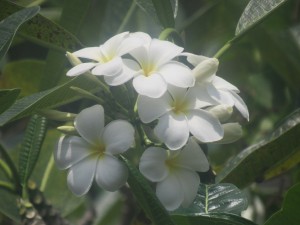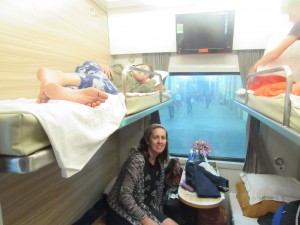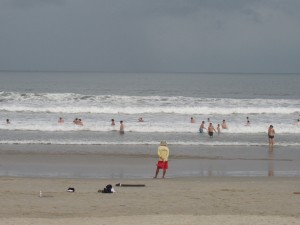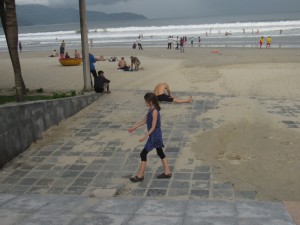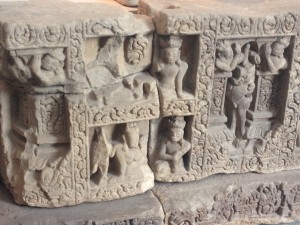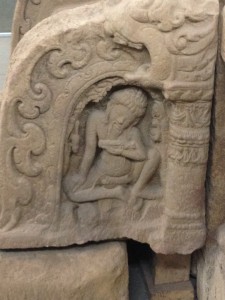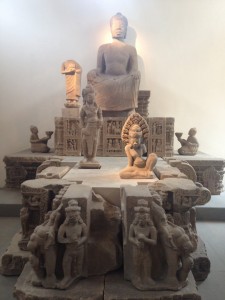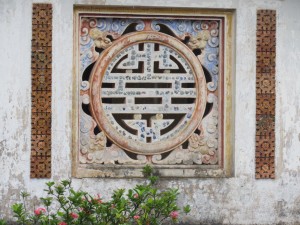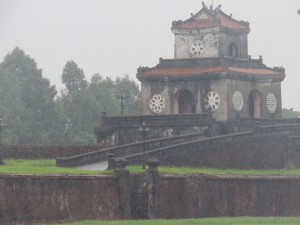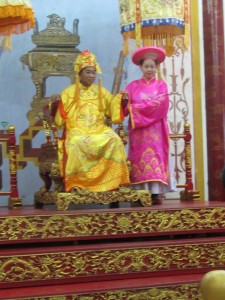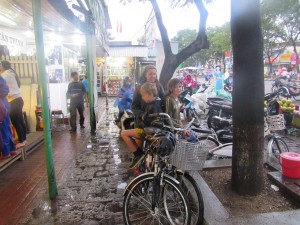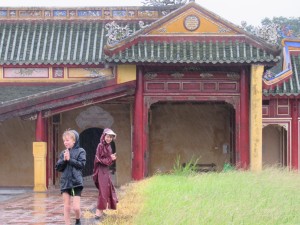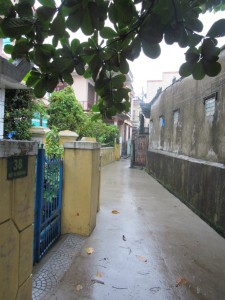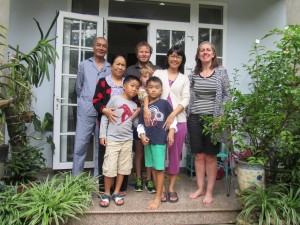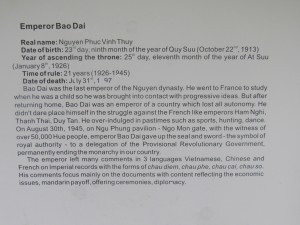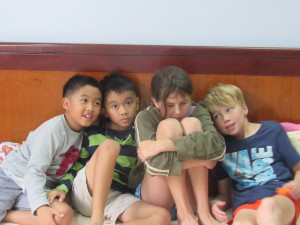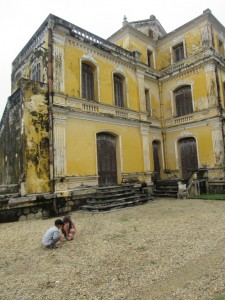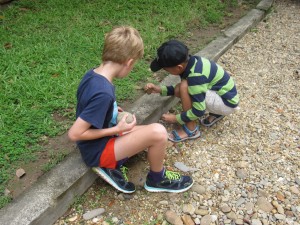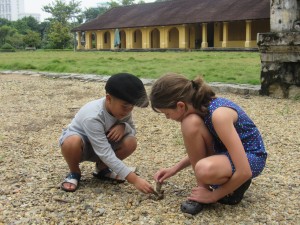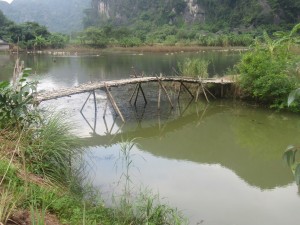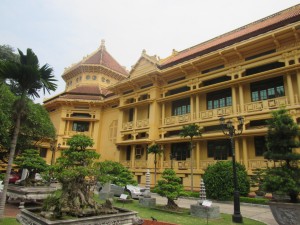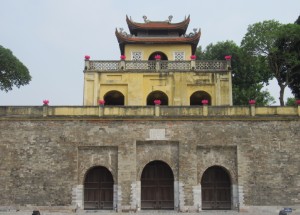We live through terrible times, and let terrible things happen. At times we find out about these atrocities only after the event. In other instances, we know they are happening (Syria, Palestine etc etc etc) and do nothing about them. Why can we not learn from history and stem the rise of despotic dictators and people who turn purely evil in the vain attempt to have their own way, ensure their ideology ‘wins’ and retort to ultra-violence in the paranoid clinging to their beliefs?
![IMG_5403[1]](http://catherine.network2innovate.com/wp-content/uploads/2015/10/IMG_54031-300x225.jpg) We deliberated about bringing Ilona and Tadhg to Choeung Ek, one of the ‘killing fields’, just south of Phnom Penh…..but in the end decided to. We talked to them about what they may see, the evil regime of Pol Pot and the suffering that Cambodians endured. We were not quite sure what to expect ourselves, but braced ourselves to patiently answer the barrage of questions that Ilona and Tadhg would throw our way. Ilona didn’t want to go, under any circumstances. In the end, she came with us, took her time to listen to the stories on her audio tour (we made sure we listened about 2min ahead of the kids, just in case something too harrowing was played), and we all walked in somber silence through the park.
We deliberated about bringing Ilona and Tadhg to Choeung Ek, one of the ‘killing fields’, just south of Phnom Penh…..but in the end decided to. We talked to them about what they may see, the evil regime of Pol Pot and the suffering that Cambodians endured. We were not quite sure what to expect ourselves, but braced ourselves to patiently answer the barrage of questions that Ilona and Tadhg would throw our way. Ilona didn’t want to go, under any circumstances. In the end, she came with us, took her time to listen to the stories on her audio tour (we made sure we listened about 2min ahead of the kids, just in case something too harrowing was played), and we all walked in somber silence through the park.![IMG_5420[1]](http://catherine.network2innovate.com/wp-content/uploads/2015/10/IMG_54201-e1445677698431-225x300.jpg)
In places, bones, teeth and clothes surface to the ground – especially after rain. It’s like the murdered souls are still not at rest, not letting people forget the brutality that was shown to them. Their last little act that forces people to remember.
It was very sad, but also very moving: and the park brings out a reverence from complete strangers to the suffering and plight of millions of Cambodians. I now just can’t help looking at Cambodians my age or older, and wondering how they survived such a brutal regime.![IMG_5413[1]](http://catherine.network2innovate.com/wp-content/uploads/2015/10/IMG_54131-300x225.jpg)
![IMG_5397[1]](http://catherine.network2innovate.com/wp-content/uploads/2015/10/IMG_53971-300x225.jpg)
The following day, we ended up going to the Genocide Museum in Phnom Penh (a miscommunication with our Tuk-Tuk driver, as we intended to go to the National Museum, but he understood the genocide museum). Here we saw the S-21 prison, where the detainees were shipped from, prior to their death at Choeung Ek. It made me feel quite sick. Humans have an incredible capacity for evil. Ilona just stayed outside in the grounds, on a bench in the shade, refusing to be exposed to any more horrible history. ![IMG_5478[1]](http://catherine.network2innovate.com/wp-content/uploads/2015/10/IMG_54781-300x225.jpg)
![IMG_5482[1]](http://catherine.network2innovate.com/wp-content/uploads/2015/10/IMG_54821-300x225.jpg)
We have been reading a book of short stories detailing personal experiences of the Pol Pot regime. The system was brutal. I cannot stop looking at men and women my age, and wonder how they survived – as they were just babies at the beginning of the purges in 1975.
I cannot stop wondering how people who are older than me survived – they all have stories to tell. I cannot stop wondering whether the young people listen to the tragedies that befell their families and country.
I also cannot stop wondering how a society heals after such immense suffering, intentional deprivation and murder. In four short years (which seemed like daily eternity, as described by the survivors, many of whom fled to the U.S. from the stories I read), a crackpot turned his country upside-down. Although a teacher himself, his paranoia and fanaticism resulted in singlehandedly getting rid of the education system; purging society of its intellectuals or anyone with half an education; the emptying of towns and cities in favour of an agrarian society, and ensuring that the townies were punished by their rural relations, by giving power and control to loyal supporters of the regime in the villages. Families were torn apart and an attempt was made to destroy the institution of family and kinship.
Societal change can hardly be achieved by revolution. I think it is a slower process. People have to question the prevailing system, see its flaws and bring all or the majority of society with them. That requires patience.

![IMG_5341[1]](http://catherine.network2innovate.com/wp-content/uploads/2015/10/IMG_53411-300x225.jpg)
![IMG_5389[1]](http://catherine.network2innovate.com/wp-content/uploads/2015/10/IMG_53891-300x225.jpg)
![IMG_5469[1]](http://catherine.network2innovate.com/wp-content/uploads/2015/10/IMG_54691-300x225.jpg)
![IMG_5393[1]](http://catherine.network2innovate.com/wp-content/uploads/2015/10/IMG_53931-300x225.jpg)
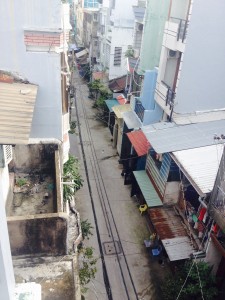
![IMG_5317[1]](http://catherine.network2innovate.com/wp-content/uploads/2015/10/IMG_53171-300x225.jpg)
![IMG_5324[1]](http://catherine.network2innovate.com/wp-content/uploads/2015/10/IMG_53241-300x225.jpg)
![IMG_5332[1]](http://catherine.network2innovate.com/wp-content/uploads/2015/10/IMG_53321-300x225.jpg)
![IMG_5323[1]](http://catherine.network2innovate.com/wp-content/uploads/2015/10/IMG_53231-300x225.jpg)
![IMG_5321[1]](http://catherine.network2innovate.com/wp-content/uploads/2015/10/IMG_53211-300x225.jpg)
![IMG_5322[1]](http://catherine.network2innovate.com/wp-content/uploads/2015/10/IMG_53221-300x225.jpg)
![IMG_5330[1]](http://catherine.network2innovate.com/wp-content/uploads/2015/10/IMG_53301-300x225.jpg)
![IMG_5345[1]](http://catherine.network2innovate.com/wp-content/uploads/2015/10/IMG_53451-e1445676778202-225x300.jpg)
![IMG_5342[1]](http://catherine.network2innovate.com/wp-content/uploads/2015/10/IMG_53421-300x225.jpg)
![IMG_5346[1]](http://catherine.network2innovate.com/wp-content/uploads/2015/10/IMG_53461-300x225.jpg)
![IMG_5356[1]](http://catherine.network2innovate.com/wp-content/uploads/2015/10/IMG_53561-300x225.jpg)
![IMG_5358[1]](http://catherine.network2innovate.com/wp-content/uploads/2015/10/IMG_53581-300x225.jpg)
![IMG_5365[1]](http://catherine.network2innovate.com/wp-content/uploads/2015/10/IMG_53651-300x225.jpg)
![IMG_5375[1]](http://catherine.network2innovate.com/wp-content/uploads/2015/10/IMG_53751-300x225.jpg)
![IMG_5373[1]](http://catherine.network2innovate.com/wp-content/uploads/2015/10/IMG_53731-300x225.jpg)
![IMG_5361[1]](http://catherine.network2innovate.com/wp-content/uploads/2015/10/IMG_53611-300x225.jpg)
![IMG_5370[1]](http://catherine.network2innovate.com/wp-content/uploads/2015/10/IMG_53701-300x225.jpg)
![IMG_5376[1]](http://catherine.network2innovate.com/wp-content/uploads/2015/10/IMG_53761-e1445678057402-225x300.jpg)
![IMG_5286[1]](http://catherine.network2innovate.com/wp-content/uploads/2015/10/IMG_52861-300x225.jpg)
![IMG_5284[1]](http://catherine.network2innovate.com/wp-content/uploads/2015/10/IMG_52841-300x225.jpg)
![IMG_5290[1]](http://catherine.network2innovate.com/wp-content/uploads/2015/10/IMG_52901-300x225.jpg)
![IMG_5297[1]](http://catherine.network2innovate.com/wp-content/uploads/2015/10/IMG_52971-300x225.jpg)
![IMG_5296[1]](http://catherine.network2innovate.com/wp-content/uploads/2015/10/IMG_52961-300x225.jpg)
![IMG_5299[1]](http://catherine.network2innovate.com/wp-content/uploads/2015/10/IMG_52991-e1445619219202-225x300.jpg)
![IMG_5120[1]](http://catherine.network2innovate.com/wp-content/uploads/2015/10/IMG_51201-300x225.jpg)
![IMG_5108[1]](http://catherine.network2innovate.com/wp-content/uploads/2015/10/IMG_51081-300x225.jpg)
![IMG_5056[1]](http://catherine.network2innovate.com/wp-content/uploads/2015/10/IMG_50561-300x225.jpg)
![IMG_5088[1]](http://catherine.network2innovate.com/wp-content/uploads/2015/10/IMG_50881-300x225.jpg)
![IMG_5074[1]](http://catherine.network2innovate.com/wp-content/uploads/2015/10/IMG_50741-300x225.jpg)
![IMG_5100[1]](http://catherine.network2innovate.com/wp-content/uploads/2015/10/IMG_51001-300x225.jpg)
![IMG_5113[1]](http://catherine.network2innovate.com/wp-content/uploads/2015/10/IMG_51131-e1445617628252-225x300.jpg)
![IMG_5087[1]](http://catherine.network2innovate.com/wp-content/uploads/2015/10/IMG_50871-300x225.jpg)
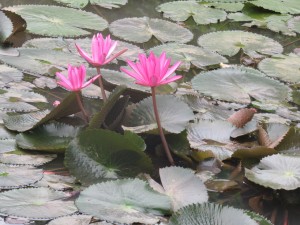
![IMG_5067[1]](http://catherine.network2innovate.com/wp-content/uploads/2015/10/IMG_50671-e1445617222575-300x225.jpg)
